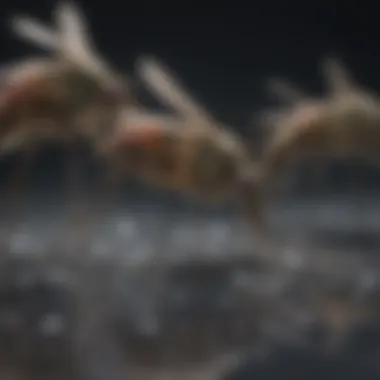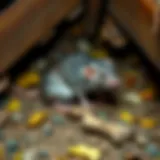BTI Pest Control: Understanding Innovative Insect Management


Intro
In the realm of pest control, the conversation is gradually shifting from conventional approaches to more innovative methods such as the use of Bacillus thuringiensis israelensis, commonly referred to as BTI. This biocontrol agent serves as a promising tool in tackling the persistent issues presented by pests like mosquitoes and termites. Households are increasingly in search of alternative solutions that are not only effective but also environmentally friendly.
This exploration aims to unravel the nuances of BTI pest control, elucidating its mechanisms, applications, and the advantages it poses for both individual homes and broader public health initiatives.
Pest Identification
Before diving deep into the strategies surrounding pest control using BTI, it’s crucial to grasp the pests themselves. A clear understanding of common pests is the first step in effective management and prevention.
Detailed Descriptions of Common Pests
- Mosquitoes: These tiny, winged nuisances are more than a mere inconvenience; they are carriers of diseases such as Zika virus and West Nile virus. Adult mosquitoes typically measure between 3 to 6 millimeters, with a slender body and elongated legs.
- Termites: Known as silent destroyers, termites can inflict significant structural damage before homeowners even suspect their presence. There are a few common types, including subterranean, drywood, and dampwood termites, each with unique characteristics affecting different areas of a home.
- Other Common Pests: Ants, cockroaches, and bed bugs often find their way into homes, leading to disruptions and potential health risks. Each pest has its own behavior, breeding habits, and preferred environments.
Signs and Symptoms of Infestations
Recognizing the signs of a pest infestation is essential for timely intervention. Here are some indicators to watch for:
- For mosquitoes, look for bites on the skin or sightings near stagnant water. They are often more active in the evening.
- Termite infestations can be identified by mud tubes along walls, hollow-sounding wood, or discarded wings.
- General signs for pests like cockroaches include droppings or a musty odor, while ants may leave visible trails.
Understanding the specific pests and their behaviors is key to implementing effective pest control methods, especially when considering BTI treatments.
Prevention Strategies
Proactive measures can significantly reduce the likelihood of pests invading your home. Here are some effective strategies:
Home Maintenance Tips for Pest Prevention
- Seal Cracks and Openings: Inspect your home for any gaps around windows, doors, and foundation. Seal these with caulk or weather stripping.
- Proper Waste Management: Keep trash bins closed and dispose of waste regularly. Pests are often attracted to food remnants.
- Landscaping Adjustments: Trim back vegetation and keep garden areas tidy to limit pest harborage opportunities.
Natural Deterrents and Barriers
- Essential Oils: Oils like peppermint or eucalyptus act as natural deterrents, making them ideal for personal spaces.
- Diatomaceous Earth: This natural powder can deter various crawling insects when sprinkled in areas of concern.
Treatment Options
Once pests do invade, treatment is necessary, and homeowners have options. Both chemical and natural treatments have their place in control strategies.
Overview of Chemical vs. Natural Treatments
- Chemical Treatments: Traditional pesticides are effective but can pose health risks to family and pets. Opting for targeted applications may still be necessary for severe infestations.
- Natural Treatments: BTI, as a biological option, specifically targets mosquito larvae and is relatively safe for non-target species, proving its worth in residential settings.
Step-by-Step Guides for DIY Treatments
- Using BTI: To apply BTI in your yard, follow these steps:
- Identify standing water bodies where mosquitoes breed.
- Apply BTI granules directly into the water following package instructions.
- Reapply as recommended to maintain effective control over larvae.
By employing these strategies and tools, homeowners can take control of their pest problems, ensuring a safer, healthier living environment. Understanding BTI helps create a lasting impact on pest management while promoting eco-sustainability at the same time.
Understanding BTI Pest Control
The topic of BTI pest control has become increasingly vital in modern pest management discussions. It's not just about keeping unwanted insects at bay; it's about adopting a method that not only protects household environments but does so in a more eco-friendly way. With the world leaning towards sustainable solutions, understanding BTI can offer homeowners and pest control professionals a pathway to effective pest management that reduces environmental impact.
BTI, or Bacillus thuringiensis israelensis, represents a key player in this shift. It stands out because it targets specific pests without harming beneficial insects, plants, or the ecosystem. This aspect alone is crucial for those who want to maintain a healthy garden or landscape. The why behind choosing BTI for pest control goes beyond mere animal management; it's about embracing a holistic approach to safeguarding our living spaces.
Defining BTI
In layman's terms, BTI is a naturally occurring bacterium that is lethal to many insect larvae, particularly mosquitoes, flies, and certain beetles. When these pests ingest BTI, it produces toxins that cause their digestive systems to shut down. This specificity makes BTI an attractive option, especially when managing pest populations with a reduced risk of collateral damage.
The benefits of this biological insecticide extend to both indoor and outdoor settings. Homeowners can apply it with confidence, knowing that it's designed to minimize risks to pets and other non-target organisms. The granules or liquids that contain BTI can be effectively used in standing water, where mosquito larvae thrive, or in areas prone to termite activity. In essence, understanding BTI means recognizing a tool that aligns with modern ecological values while still being effective against pests.
Historical Context
To appreciate BTI's role in pest control today, it's essential to look back at its roots. The first strains of Bacillus thuringiensis were discovered in the early 1900s by a Japanese scientist named Shigetane Ishiwata. Initially noted for their insecticidal properties, these strains led to the formulation of various BT products over the decades. The 1970s marked a significant turning point, as BTI was isolated specifically for its effectiveness against mosquito larvae.
As pest control landscapes shifted through the late 20th century, homeowners began seeking alternatives to chemical pesticides. The emergence of environmentally-conscious attitudes created a demand for safer, less harmful solutions. BTI found its niche, particularly in areas where chemical pesticide use posed risks to human health and surrounding ecosystems. Today, this tool is firmly established, with extensive product formulations available to address specific pest issues people face in their homes and communities. Understanding this historical context underlines the importance of BTI in the ongoing search for balance between effective pest management and environmental stewardship.
"Choosing BTI pest control isn't just about managing pests; it's about sustainable living that preserves the health of our environment."


Mechanism of Action
Understanding the mechanism of action is crucial to fully grasp how BTI pest control operates in managing insect populations. This section elucidates the biological characteristics of Bacillus thuringiensis israelensis and its specific action against various pest species. Fast becoming a preferred approach in integrated pest management, BTI’s unique action aligns well with the growing emphasis on sustainable agricultural practices and public health benefits.
Biological Characteristics
Bacillus thuringiensis Overview
Bacillus thuringiensis, commonly referred to as BT, is a naturally occurring bacterium renowned for its insecticidal properties. This bacterium produces crystal proteins during its sporulation phase, which upon ingestion by target pests, disrupt their digestive systems leading to mortality. What sets it apart is its specificity; BT primarily targets insects in their larval stages without affecting beneficial organisms.
This specificity makes BT a popular choice for pest control as it dramatically reduces collateral damage to non-target species, thus promoting ecological balance. A unique aspect of BT is its ability to thrive in varied environments, from moist conditions near aquatic habitats to dry soils, enhancing its applicability in pest management strategies.
Classification and Variants
Classification and variants of Bacillus thuringiensis significantly contribute to its utility in pest control. There are many strains of BT, each with unique characteristics tailored for different pest species. For instance, BT var. israelensis is particularly effective against mosquito larvae, whilst BT var. kurstaki is utilized for controlling caterpillars.
The dread of pest resistance is addressed by this diverse classification, allowing the rotation of strains, minimizing the chances of pests developing resilience. However, it’s essential to recognize that not all BT strains are interchangeable; understanding their specific targets and habitats ensures effective pest management.
Mode of Action Against Pests
Target Species
The target species for BT pest control play a pivotal role in determining its effectiveness. BT is most effective against soft-bodied insect pests, particularly larvae like mosquitoes, moths, and certain beetles. The potency of BT against these species lies in its capacity to be ingested and subsequently disrupt normal physiological functions, leading to their eventual death.
Why is this significant? Using BT allows for a targeted approach that can significantly reduce pest populations without harming beneficial organisms. Moreover, this selectivity helps to maintain the natural predator-prey dynamics in the ecosystem, thereby fostering long-term sustainability in pest management practices.
Effect on Larval Stages
The effect on larval stages is where BT showcases its immense value as a pest control agent. The susceptibility of larval insects to BT's crystalline proteins means that controlling pests during this early life stage is most effective. Once ingested, these proteins are activated by the alkaline conditions of the insect’s gut, leading to a cascade of physiological reactions that ultimately result in lethal outcomes for the larvae.
But there's more—this mode of action doesn't just provide immediate results; it also severely hampers the ability of larvae to transition into the adult phase, interrupting their life cycle and reducing future populations. Although BT does not have the same residual activity as chemical pesticides, its targeted efficiency compensates by needing fewer applications when used correctly.
"Understanding how BT works effectively helps in leveraging it to its fullest potential, especially in ecologically sensitive areas."
Comparative Analysis
Understanding how BTI pest control measures up against traditional pesticides gives valuable insight into its usage and effectiveness. This comparative analysis shines a spotlight on several aspects: toxicity levels, environmental impact, and effectiveness. Each of these elements plays a pivotal role in determining pest control strategies that are safe, sustainable, and target specific pest populations effectively.
BTI vs. Chemical Pesticides
Toxicity Levels
Toxicity levels are crucial when assessing pest control methods, especially regarding safety for humans and pets. With BTI, the toxicity is distinctly lower than that of many chemical pesticides. This characteristic makes BTI a favorable option for residential and public health initiatives. In sharp contrast, chemical pesticides often carry substantial risk due to their broader toxicity spectrum.
- Key Characteristic: BTI specifically targets insect larvae, showcasing much less risk to other organisms.
This targeted mechanism not only preserves beneficial insects but also reassures homeowners about the safety of their living environments. Conversely, the potent toxicity of chemical pesticides can lead to unintended harm, spurring some to rethink their pest control choices.
Environmental Impact
When it comes to environmental ramifications, BTI presents a noteworthy advantage. The unique microbial action of BTI poses minimal threat to non-target species, thus maintaining ecological balance. Chemical pesticides, however, can lead to land and water pollution, contributing to broader environmental degradation.
"Adopting BTI can help reduce the chemical footprint in pest management, promoting healthier ecosystems for communities."
- Key Characteristic: BTI biodegrades naturally, enabling safer runoff and less long-term environmental damage.
Such an approach not only aligns with sustainable practices but also has the potential to foster positive community outcomes. In contrast, reliance on chemical pesticides typically results in a chain reaction of adverse ecological impacts, highlighting the importance of sustainable pest control strategies.
Effectiveness
Effectiveness in controlling pests is naturally paramount. BTI proves highly effective against specific pests, particularly mosquitoes and black flies, by directly targeting their larvae. The pronounced effectiveness exhibited against these larvae indicates a focused strategy that traditional pesticides often lack.
- Key Characteristic: BTI's effectiveness diminishes only against the targeted pest stages, providing a laser-focused solution.
Although traditional pesticides may offer broad spectrum action, they often come with drawbacks such as pest resistance and harmful side effects on non-targetspecies. This unequal effectiveness could compel users to consider switching to BTI-based solutions.
Benefits Over Traditional Methods
Targeted Action


Targeted action embodies BTI's effectiveness; it zeroes in on pest larvae while sparing beneficial insects. This precision contrasts vividly with broad-spectrum chemical pesticides, which often indiscriminately annihilate many beneficial species alongside pests. By focusing on specific life stages, BTI ensures that the environment suffers as little collateral damage as possible.
- Key Characteristic: BTI’s targeted action allows for effective pest elimination with minimal environmental disruption.
This approach resonates with homeowners keen on maintaining balanced ecosystems while combating nuisances. Thus, the choice to implement BTI becomes not only a matter of effectiveness but also one of responsibility.
Sustainable Practices
Sustainable practices are at the heart of modern pest management, and BTI aligns seamlessly with this commitment. Deploying BTI ensures that pest control is not merely an act of eradication but a step toward fostering ecological harmony. The lack of persistent chemicals in BTI means that using it doesn’t contribute to the toxic buildup seen in ecosystems bombarded by chemical options.
- Key Characteristic: BTI'degrades naturally, thus supporting an eco-friendly approach to pest management.
This facet underlines the importance of choosing methods that not only work well but also contribute positively to the planet. Therefore, homeowners are increasingly seeing BTI as a sustainable alternative that promotes health for both people and the environment.
Application in Pest Management
When we talk about tackling pesky pests, it’s all in the details of how we get rid of them. BTI pest control isn’t just some trendy tip; it’s a game changer in managing nasty insect populations like mosquitoes and termites. The applications of BTI in pest management are straightforward yet impactful, making a significant difference in maximizing efficiency while minimizing potential harm to other species and the environment.
Residential Use
In residential settings, the application of BTI is crucial. Homeowners want solutions that are not only effective but also safe around their families and pets. This is where BTI shines.
Indoor Applications
Inside the four walls of a home, effective control of pests can be a tall order. Indoor applications of BTI make that task much simpler. Utilizing this biological control method targets larval stages of insects effectively without the use of harsh chemicals.
One key characteristic of BTI is its mode of targeting only specific types of pests, such as mosquitoes and certain flies. For homeowners, this means peace of mind. Using BTI means you're not bombarding your home with toxic sprays that can linger, risking the health of your loved ones. It’s a popular choice because not only is it effective, but it also aligns with growing demands for eco-friendliness in pest management.
The unique feature of indoor applications is the method of delivery. Spray formulations or granules can be placed strategically in areas where these pests are likely to breed, such as standing water setups or drains. One advantage is the long-lasting residual effect, while the disadvantage might be the necessity of targeted application spots, which could require more careful planning to ensure effectiveness.
Outdoor Applications
Moving outside, the stakes change a bit, but BTI still holds its ground in outdoor pest management strategies. Outdoor applications address larger areas and populations, often bringing relief from bothersome mosquito swarms during summer evenings.
The key characteristic here is its ability to treat water bodies. BTI can be deployed in ponds or other stagnant water to control mosquito larvae where they breed. This preventative approach not only eliminates potential breeding spots but also reduces future outbreaks. Since it’s non-toxic to humans and pets, it's an appealing way to enjoy outdoor spaces without fear of chemical exposure.
Despite its advantages, outdoor applications can be less predictable due to environmental factors. Heavy rainfall, for instance, can wash away BTI, demanding frequent reapplication. Therefore, regular monitoring and adjustment become necessities to maintain its effectiveness.
Commercial Use
Now, the stakes are even higher when we shift to commercial settings. Businesses, especially those in the hospitality and healthcare sectors, are increasingly relying on BTI to manage pests ethically and effectively.
Public Health Considerations
In commercial use, public health considerations take center stage. The implications of pest control on human populations are critical, and BTI prides itself on being a safe alternative to traditional methods. Additionally, with rising concerns about chemical pesticide abuse and resistance, BTI offers a refreshing choice that satisfactorily meets regulatory demands.
A standout feature is its low toxicity to non-target species and humans, making it highly beneficial. It helps mitigate risks of pesticide exposure that are common in conventional pest control. One crucial advantage of this aspect is embracing the public's growing preference for safer, responsible pest management solutions. However, the unique feature here could also become a disadvantage if not correctly managed. Public education on proper usage can sometimes lag behind implementation, resulting in skepticism toward effectiveness.
Targeting Specific Pests
Lastly, targeting specific pests is vital for commercial operations. BTI’s effectiveness against particular larvae means businesses can develop more strategic pest management plans, directly addressing problems without collateral damage.
The main attractions of targeting specific pests include cost-effectiveness and efficient resource use, making for an optimized pest control strategy. Adapting to the specific needs of an operation allows businesses to save time and minimize waste.
Nonetheless, there’s a flip side. If a business faces a wide range of pest challenges, sticking to a narrow-spectrum control method might ultimately leave some pest issues unaddressed. Thus, continual evaluations of pest situations need to be mandatory to maximize the benefits of BTI in such settings.
The application of BTI pest control, both in residential and commercial contexts, highlights the tension between traditional methods and modern demands for sustainability and efficiency.
Ultimately, BTI represents a balance between effective pest management and the preservation of non-target species, which resonates with the goals of responsible pest control in today’s eco-conscious world.
Environmental Considerations
When discussing BTI pest control, one can't overlook the significance of environmental considerations. This topic serves as the backbone for understanding how BTI impacts not just targeted pests but the entire ecosystem. As households increasingly strive for sustainable solutions, the implications of pest control methods on the environment warrant careful scrutiny. Balancing effective pest management with ecological integrity is critically important.
Impacts on Non-Target Species
The term non-target species refers to the animals and organisms that are not intended to be affected by pest control methods. With BTI, the focus is mainly on mosquitoes and other harmful insects. However, this brings up an important question: what happens to other wildlife in the vicinity? While BTI has shown a favorable profile, especially when compared to traditional chemical pesticides, there are nuances that need attention.
BTI's specific mechanism of action primarily affects the larval stages of certain insects like mosquitoes, but what about other aquatic life? Research indicates that when used properly, BTI poses a minimal risk to non-target organisms such as fish and beneficial insects. This is crucial since many ecosystems rely on a diverse insect population. Some studies have shown that the application of BTI can even help promote certain beneficial insects, as it disrupts the life cycle of pests without harming their natural predators.


It's important to encourage an understanding of how this pest control solution can align with efforts to protect biodiversity. Integrative pest management strategies, spotlighting BTI, can lead to beneficial outcomes for all species that share the same habitat.
Regulatory Framework
The landscape of pest control is governed by various regulations aimed at protecting public health and the environment. The regulatory framework that surrounds BTI usage is essential to its adoption and application. Strict guidelines ensure that the use of BTI is both safe and effective, shaping policies that underpin its integration in pest control programs.
In many regions, the registration of BTI as a biopesticide confirms its safety for humans and wildlife. Regulatory bodies like the Environmental Protection Agency (EPA) in the United States require rigorous testing before any biopesticide, including BTI, is allowed on the market. Their evaluations take into account not just efficacy against pests, but also potential side effects on non-target species. Such measures ensure public confidence in the safety of products used for pest management.
Furthermore, understanding local regulations regarding BTI can help homeowners make informed decisions. This ensures compliance while employing environmentally friendly pest control solutions. For individuals or companies considering its application, becoming familiar with policies can foster a culture of responsible pest management. By embracing BTI within these regulatory frameworks, we position ourselves to engage in sustainable practices that safeguard both our homes and the environment.
"Sustainable practices aren't just good for the environment; they're essential for our well-being and future."
In summary, looking at the environmental considerations associated with BTI pest control provides clarity on its broader implications. Its targeted action minimizes risks to non-target species while operating within a solid regulatory framework, positioning it as a sensible choice in a growing eco-conscious society.
Research and Development
Research and development in the field of BTI pest control plays a pivotal role in shaping effective and sustainable strategies for pest management. As the pest control landscape evolves, the need for innovative approaches becomes more pronounced. BTI's unique composition and its environmentally friendly nature offer a way forward. Here, we'll dive into some recent studies and the future directions in BTI research, emphasizing their significance for homeowners looking for alternative solutions to pest problems.
Recent Studies
In recent years, several studies have underscored the efficacy of BTI in pest control. For instance, a study published in the Journal of Applied Entomology explored how Bacillus thuringiensis israelensis specifically targets larvae of mosquitoes, an area where conventional pesticides often falter. The researchers found that BTI's effectiveness hinged on its ability to produce proteins that disrupt larvae growth, thereby preventing them from maturing into adult mosquitoes.
This kind of research matters for many reasons. First, it provides evidence-based methods that homeowners can trust. Second, it highlights BTI’s potential over chemical alternatives in various environments, be it residential habitats or public health projects.
Moreover, a comparative study of BTI and traditional pesticides noted a marked decline in target pest populations when using BTI, reinforced by minimal side effects on beneficial insect populations. These findings challenge long-held perceptions about the effectiveness of non-chemical pest control measures, making a strong case for BTI's inclusion in pest management practices.
Future Directions in BTI Research
As we look toward the future, several exciting avenues are emerging in BTI research. One prominent trend involves enhancing the effectiveness of BTI formulations. Scientists aim to engineer strains of Bacillus thuringiensis with improved potency or longer-lasting effectiveness. Such developments could broaden the range of pests that BTI can target, potentially extending from mosquitoes to other troublesome critters like flies and beetles.
Furthermore, another line of research focuses on combining BTI with other biological control methods. This multi-pronged approach may lead to synergistic effects, where the combined use of BTI with other natural predators or deterrents boosts overall effectiveness against pests.
The integration of different biological controls may lead to more sustainable and effective pest management solutions, benefitting not just homeowners but the environment at large.
Lastly, public perception remains a significant barrier in adopting BTI for pest control. Future studies on educating homeowners about the safety and effectiveness of BTI could play a critical role in increasing its usage in residential areas. Implementing awareness campaigns and further disseminating research findings will empower homeowners to make informed decisions.
In closing, the continuous research and development surrounding BTI pest control pave the way for innovative solutions in managing pests more responsibly. As new studies emerge and more effective formulations are developed, it’s crucial for homeowners to stay informed about their options, aligning pest control practices with eco-friendly values.
Challenges in Implementation
Implementing BTI pest control strategies carries certain challenges. Understanding these can make a significant difference in effectively managing pests while minimizing risks to non-target species and the environment. These challenges range from biological factors to public perception, each with its own implications for sustained success.
Resistance Development
One of the primary concerns is the potential development of resistance among target pest populations. Just as bacteria can evolve to resist antibiotics, insects exposed to BTI may develop resistance to its effects over time. This phenomenon can be likened to a game of cat and mouse, where adaptation occurs, leading to the reduction of BTI's effectiveness.
Experiments and studies are ongoing to monitor and mitigate resistance development. For instance, rotating different pest control methods or using BTI in combination with other biocontrol agents can help maintain its efficacy. Effective monitoring of pest populations, as well as listening to the pest control professionals, plays a vital role in addressing this issue.
"Continuous research is essential to stay ahead of resistance development, ensuring BTI remains a reliable option for pest control."
Public Perception and Misconceptions
Another considerable challenge is the public's perception of BTI pest control. Many homeowners might feel hesitant about using a biological agent due to a lack of familiarity. Misunderstandings about the safety and effectiveness of BTI can create significant barriers to adoption. Some may fear it's harmful to humans or pets, despite studies showing low toxicity.
Educating the public about BTI—starting from its natural origins to its targeted action against pests—can alleviate concerns. Homeowners should understand that BTI specifically targets certain pest larvae, thus keeping beneficial insects such as bees safe. On top of that, organizing community workshops or information sessions can promote awareness and foster a more favorable view toward using BTI in residential and commercial pest control strategies.
Successful pest management hinges on overcoming these challenges. By creating a better understanding of resistance development and addressing public perception, BTI can secure its place as a trusted method for pest control.
Finale
The conclusion serves as the final bow in the performance of understanding BTI pest control, summarizing the insights derived from a thorough exploration of its effectiveness and tactical applications. In a landscape where pest management is becoming an increasingly pressing concern for homeowners and pest control professionals alike, recognizing the role of Bacillus thuringiensis israelensis is crucial. This biological method stands out not just for its pest-killing ability, but also for its relatively low toxicity to humans and non-target species, promoting a safer environment for both residential areas and the ecosystem.
Recap of BTI Efficacy
To put it simply, BTI pest control has proven itself to be a formidable partner in the fight against persistent pests such as mosquitoes and termites. Through the targeted action of BTI, the larval stages of these pests are disrupted effectively, reducing their population without the collateral damage characteristic of many chemical pesticides. The benefits are manifold: from ecological preservation to health safety, this method aligns perfectly with the growing trend of sustainable practices.
Key points to remember include:
- Efficiency in targeting specific pests without harming beneficial insects.
- Reduced health risks due to low toxicity levels for humans and pets.
- A positive environmental footprint, preserving biodiversity in treated areas.
"By integrating BTI pest control into a home management plan, homeowners are not only addressing immediate pest issues but are also contributing positively to long-term ecological health."
Call for Continued Research and Awareness
Though the efficacy of BTI pest control is promising, ongoing research is needed to navigate its future. Science evolves continuously, and therefore, refreshing our understanding and expanding the applications of BTI is vital. There are still gaps in knowledge about resistance development and potential shifts in pest behavior, which could affect the effectiveness of BTI in the long term. As such, fostering awareness around the benefits of BTI needs innovation and commitment.
Considerations for the future should focus on:
- Promoting educational initiatives that inform the public about the advantages and limitations of BTI pest control.
- Encouraging collaborative research to discover novel applications of BTI that could combat emerging pest challenges.
- Elevating community engagement to dispel myths and misconceptions about biological pest control methods.



